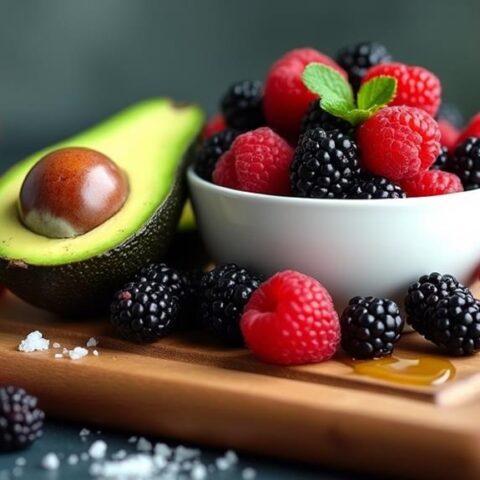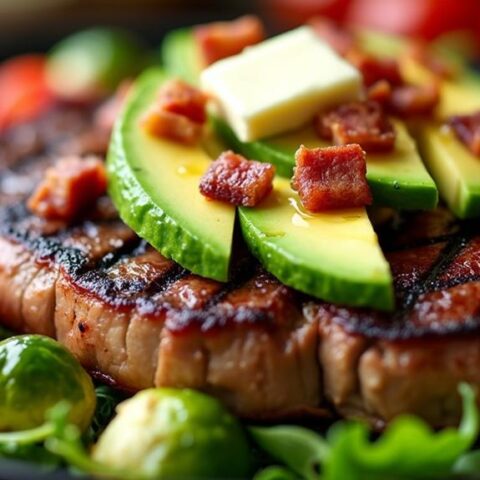
Ham is generally a low-carb food choice, containing less than one gram of carbohydrates per serving in its unprocessed form. Plain, unglazed varieties are perfect for low-carb and keto diets, while honey-glazed or processed versions may contain hidden sugars, raising the carb count to around 4 grams per serving. For best results, consumers should check nutrition labels and choose unsweetened varieties, as preparation methods can greatly impact carbohydrate content.
Key Takeaways
- Ham contains less than 1 gram of carbohydrates per slice, making it an excellent choice for low-carb diets.
- Plain, unprocessed ham varieties are best for strict carb control, while honey-glazed versions can contain up to 4g net carbs.
- Check nutrition labels carefully, as processed hams may contain hidden sugars and carbs from additives or curing agents.
- Regular deli ham is a high-protein, low-carb option that fits well into ketogenic and carb-restricted meal plans.
- Ham can be paired with low-carb vegetables and full-fat cheese for satisfying, carb-conscious meals.
Understanding Ham's Nutritional Content
Ham's nutritional profile makes it an excellent choice for those following a low-carbohydrate diet. Traditional plain ham contains less than 1g of carbs per slice, aligning perfectly with keto-friendly meal plan requirements.
However, understanding the carb count variations among different ham products is vital for maintaining ketosis. When selecting ham, particularly processed varieties, careful attention to nutritional labels is important.
While deli-sliced ham typically contains zero carbs, specialty preparations like honey-glazed versions can include added sugars that greatly increase the carb content to approximately 4g per serving.
For those strictly monitoring their carbohydrate intake, choosing unadorned, plain ham varieties guarantees better control over daily carb consumption and helps avoid hidden sugars that could potentially disrupt ketosis.
Types of Ham and Their Carb Counts
When exploring different varieties of ham available in the market, consumers will find significant variations in carbohydrate content depending on preparation methods and added ingredients.
For those following a low carb meal plan or aiming to maintain ketosis, understanding these differences is essential.
- Traditional sliced deli ham contains minimal carbohydrates per serving (<1g)
- Plain, unprocessed varieties are ideal for strict low-carb diets
- Honey-baked ham has higher net carbs per serving (around 4g)
- Cured and smoked types generally remain low in carbs (under 2g)
- Glazed or marinated hams may contain hidden sugars
While most types of ham can fit into a low-carb lifestyle, processed varieties require careful consideration.
Reading labels and choosing plain options helps guarantee adherence to carbohydrate restrictions while enjoying this versatile protein source.
High-carb snacks like potato chips should also be avoided to maintain ketosis.
Best Ham Choices for Low-Carb Diets
Selecting the right type of ham proves essential for individuals following a low-carb eating plan, as some varieties can derail dietary goals while others fit perfectly within restrictions.
Traditional deli ham serves as an excellent protein source, containing less than 1g of carbs per slice, while being high in fat and protein to support a low-carb meal plan.
Deli ham offers a protein-packed choice for low-carb dieters, delivering minimal carbs while providing essential fats and protein.
When shopping, carefully review the nutrition label and ingredients list for hidden carbs, particularly in processed hams. Look specifically for products labeled "no sugar added" and avoid honey-baked varieties, which can contain up to 4g of carbs per serving.
To maximize the benefits of ham in a low-carb diet, pair it with low-carb vegetables in salads or incorporate it into protein-rich breakfast dishes like omelets.
Adopting a low-carb diet, such as the ketogenic diet, can result in improved insulin sensitivity, which is beneficial for managing blood sugar levels, particularly in individuals with type 2 diabetes.
Hidden Carbs to Watch for in Processed Ham
Many processed hams contain hidden carbohydrates that consumers might overlook while following a low-carb diet. When selecting processed ham, careful attention to the nutrition label is crucial, as total carb content can vary considerably between brands and varieties. Honey-glazed and sweetened hams may contain up to 4g net carbs per serving. Hidden sugars often appear in curing agents and flavor enhancers. Deli meats labeled as 0g carbs may still contain trace amounts of additives. Glazes and marinades can dramatically increase carb amounts. Serving sizes listed on packages may be smaller than expected portions. To maintain a strict low-carb diet, consumers should opt for high-quality, unsweetened varieties of ham with minimal processing. Reading ingredient lists thoroughly helps identify potential sources of hidden carbs and guarantees better alignment with dietary goals.
Tips for Incorporating Ham Into Your Low-Carb Meals
Several practical strategies exist for incorporating ham into low-carb meal plans while maximizing flavor and nutritional benefits. Traditional deli ham serves as an excellent protein source, containing minimal carbohydrates while offering versatility in meal preparation. To create balanced meals, combine ham with low-carb vegetables like spinach or zucchini, ensuring both nutritional variety and satisfaction. For creative meal solutions, use ham as a filling in omelets or pair it with full-fat cheese to enhance rich flavors while keeping carb intake low.
Frequently Asked Questions
Is Ham Okay for a Low-Carb Diet?
Plain ham fits well into low-carb diets, especially uncured varieties. Traditional sliced deli ham contains minimal carbohydrates, though honey-glazed versions should be avoided. Moderate portions support weight loss goals while providing protein.
Is Ham Full of Carbs?
Plain ham contains minimal carbohydrates, typically less than 1g per serving. However, honey-glazed or processed varieties may contain 4-5g per serving due to added sugars and preservatives during preparation.
What Meat Is Best for a Low-Carb Diet?
Lean meats, fatty cuts, and red meats like beef provide excellent protein sources. Poultry options, game meats, and seafood varieties offer versatile low-carb choices. Avoid heavily processed meats with added sugars.
What Foods Should You Avoid on a Low-Carb Diet?
Low-carb dieters should avoid sugar alternatives, processed snacks, starchy vegetables, bread products, sugary drinks, high carb fruits, legume varieties, pasta dishes, grain-based cereals, and sweet sauces to maintain ketosis.
Conclusion
Ham can be an excellent choice for low-carb diets when selected and prepared thoughtfully. Plain, unglazed ham contains minimal carbohydrates, making it suitable for most low-carb meal plans. However, consumers should carefully read labels and avoid processed varieties with added sugars or honey glazes. By choosing natural, minimally processed ham and pairing it with low-carb sides, individuals can enjoy this protein-rich meat while maintaining their dietary goals.










No Comments